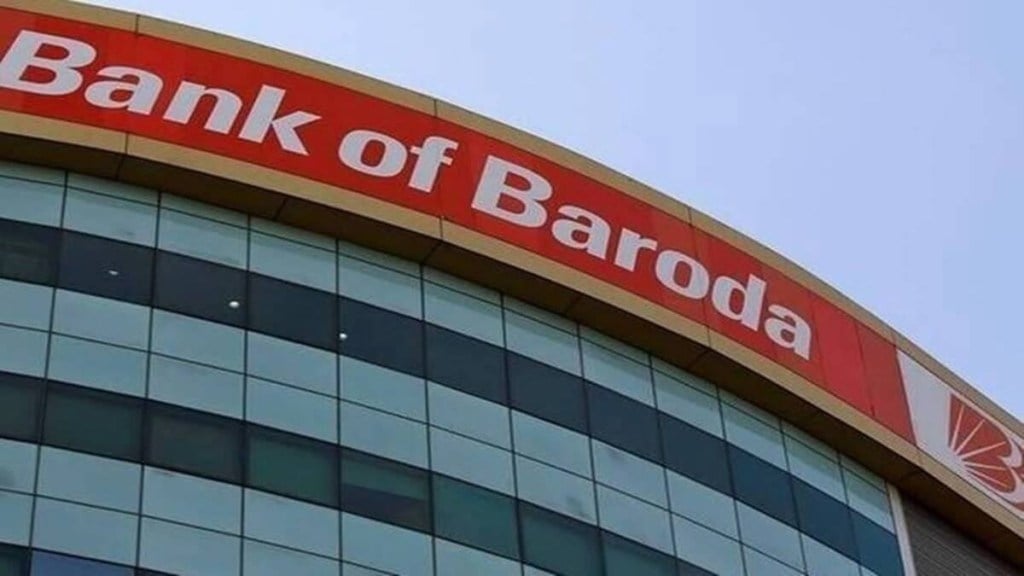Public sector major Bank of Baroda‘s (BoB) overall market capitalisation breached the Rs 1-trillion mark on June 19, making it the second PSU bank to have achieved this feat after the State Bank of India.
The bank’s shares ended trading 1.65% higher at Rs 198 on the Bombay Stock Exchange on Wednesday. According to Vaishali Parekh, vice-president of Technical Research at Prabhudas Lilladher, the bank’s stock is currently in its resistance zone from where it will need a decisive breakout to carry on the momentum ahead.
“The near-term support will be near Rs 189 levels and with the overall trend maintained positive, one can hold on the long position till 182 level (50 EMA) is sustained,” she said.
A combination of factors has led to the overall market rally in the bank’s stocks, experts say, including the successful merger of Vijaya Bank and Dena Bank with the bank in 2019. “With the support of the government and mergers creating large players, banks were able to write off bad loans and clean up their books,” says Sanjay Agarwal, senior director at CareEdge Ratings.
Agarwal added that the merger also brought in a decent amount of upgrades in PSU banks’ processes. A research paper released by the Reserve Bank of India (RBI) in December also corroborated the fact that the efficiency of acquirer banks improved post-merger due to an increase in scale and productive capacity, and also simultaneously increased acquiree banks’ shareholders’ wealth.
Performance metrics
BoB managed to outpace its peers in growth and asset quality metrics. For example, the bank’s overall advances grew 18.5% year-on-year (YoY) to Rs 9.69 trillion as of March-end. In comparison, Punjab National Bank and HDFC Bank’s overall advances grew 13% and 17% on a yearly basis to Rs 8.84 trillion and Rs 16 trillion, respectively, as of March 31.
Not just advances, but BoB was able to grow its deposits by 15.1% on-year to Rs 12.04 trillion as of March end, the highest pace of deposit growth among its peer PSU banks. Even the net interest margin (NIM) grew 28 basis points (bps) on year to 3.31%, a tad lower than the 3.37% NIM registered by the country’s largest bank, the State Bank of India.
A substantial part of the bank’s higher business growth came from its application BoB World, which had added 20 million customers over 2 years. In a recent interview with Fe, the bank’s Chief Digital Officer Akhil Handa said BoB passed nearly Rs 70,000 crore of digital loans in FY23, and for FY24, the bank is targeting Rs 90,000 crore of digital loans, of which about 30% of loans will be purely end-to-end digital.
On the asset quality front, the bank’s gross and net non-performing asset (GNPA & NNPA) ratio improved to 3.79% and 0.89% as of March-end. The asset quality is further likely to improve in FY24, the bank’s MD and CEO Sanjiv Chadha told FE in an interview.
Why PSU valuations lag private banks?
While BoB is the second PSU bank to enter the Rs 1 trillion landmark, there are many more private sector banks that have already crossed it. For example, HDFC Bank, ICICI Bank, Axis Bank, and Kotak Mahindra Bank have all crossed the Rs 1 trillion benchmark. HDFC Bank is the most valued lender with a market capitalisation of Rs 9.14 trillion as of June 21, followed by ICICI Bank’s market capitalizsation of Rs 6.46 trillion, Kotak Mahindra Bank at Rs 3.66 trillion, and Axis Bank’s Rs 2.97 trillion.
According to Pankaj Pandey, head of research at ICICI Securities, this difference is there because private banks’ historical growth rate has been a lot better. One more factor that is extremely important in the banking sector is RoA. Typically, most of the bigger private banks deliver RoAs closer to 2%, which is why they command valuations of 2.5 times to three times the forward book. Whereas when you see PSU banks, RoA is below 1%.
Another reason, according to Pandey, is that the risk assessment of PSU banks has been weak compared to the private sector, leading to higher provisions and higher credit costs which affect profitability. “Subsequently, the government has to recapitalise the banks, and if you are putting a lot more money in the bank, then you are diluting the RoEs which again is counterproductive,” he added.
Ajit Kabi, banking analyst at LKP Securities, said the previous asset quality cycle was harsher to PSU banks as compared with private ones. The wholesale credit book was more distressed than retail. However, improvement in asset quality has rejuvenated growth, resulting in re-rating of PSU banks. Bank of Baroda has led the PSU banks with early recovery in credit quality and strong balance sheet growth. Nevertheless, comparing with large private sector banks, the PSU banks have to prove their mettle, going forward.

